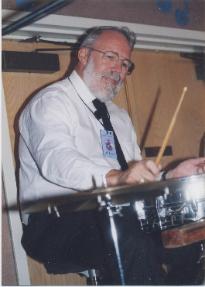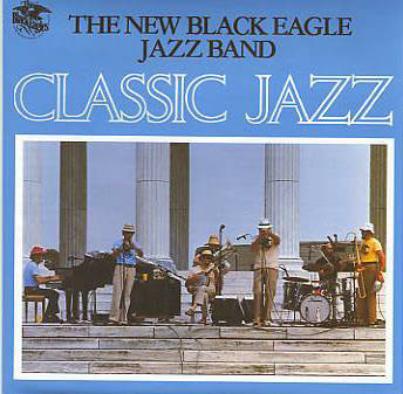Playing time: 72m. 20s.
Spreading Joy; Chicago Breakdown; Bombay; She’s Crying for Me; Short Dress Gal*; Old
Stack o’ Lee Blues; Funny Fumble; Roamin’; Grandpa’s Spells; Working Man Blues;
Skeleton in the Closet; Rent Party Blues; Love Songs of the Nile; Shake It and Break It.
Recorded at WGBH, Boston, MA, on Dec. 28, 1976 (first nine tracks) and Jan. 3, 1978 (last
five tracks).
Personnel: Tony Pringle, cornet, vocal*, and leader; Stan Vincent, trombone; Stan
McDonald, clarinet, soprano sax; Bob Pilsbury, piano; Peter Bullis, banjo and manager;
“Pam” Pameijer, drums; Eli Newberger, tuba.
This is the twelfth in a series of fourteen limited edition CD’s, reissuing material by the
band that previously appeared on LP’s—mainly on their own label but also on a few
other small labels, such as Philo, Philips, and Dirty Shame—and on cassette tapes.
Some of these cassettes were issued simultaneously with the LP’s but also contained
additional tracks. Other cassettes with different material were issued in that format
only. When the company that produced the cassettes went out of business, the digital
masters were returned to the band. These form the basis of most of the material on this
CD set.
The composers of the tunes on this CD comprise a veritable jazz composers’ “Hall of
Fame,” with names such as Sidney Bechet, Jelly Roll Morton, Tiny Parham, Santo
Pecora, Sam Morgan, King Oliver, Duke Ellington. And their compositions have
become, indeed, “classics”: Bechet’s Spreading Joy, Morton’s Grandpa’s Spells, Morgan’
s Short Dress Gal, Oliver’s Working Man’s Blues, Ellington’s Rent Party Blues, with nary
a warhorse among them. Their rendition by the New Black Eagles might also be
dubbed “classic.”
The program begins with a romping, stomping Spreading Joy, taken at a very brisk
tempo in an undeviating four-four, here as elsewhere Newberger confounding the
listener with his magical circular breathing. Although he may not be breathless at the
end, the listener almost is. And so it continues straight through to the closing number,
Shake It and Break It, a cooker which seems to accelerate a little as it proceeds but is
certainly a rousing note on which to end.
In between, the band displays some of the signature devices for which it became
known. In several of the tunes there are subtle changes in texture, particularly where
everyone drops out except for the tuba and banjo, the tuba playing lead. In other places
different instrumental groupings occur for some choruses, such as piano with drums
and banjo accompaniment (no tuba), or cornet with the same accompaniment.
Ensembles are given preference, especially on the out-choruses, and there is the gradual
build-up of tension and excitement via the carefully employed dynamics.
By the time of these recording sessions these men have developed a fine rapport and
can well anticipate what each other will do. That, coupled with the band’s telling
discipline, results in superb renditions. There are quite a few memorable moments,
such as the crisp opening ascending run taken by Pringle on Grandpa’s Spells and
Pameijer’s nice accents on the same tune. His woodblocks on She’s Crying for Me also
provide a most effective opening, and in that same tune the shifting between keys is
effortless. It always surprises me that so few bands have this number in their
repertoire. Another tune, a good one, that is not in many bands’ “books” is Love Songs
of the Nile, a song from the movie The Barbarian (1933) and which Billie Pierce, pianist
and vocalist who played in New Orleans from some twenty years, made her own as she
along with her husband De De led bands at Preservation Hall. The movie may have
sunk into oblivion, but the song survives.
The first nine tunes were recorded in one session and issued on a Philips LP, and the
last five in one a year or so later. The personnel in both sessions was the same, as was
the engineer, but the sound is a little different between the two. That of the first is
warmer, but that of the second provides clearer definition of the instruments. No other
tracks were extant from the first session, but fortunately those from the second survived
and after the tapes were “baked” allowed for a full-length CD, one which all fans of the
band will want to have, as should anyone who fancies him- or herself a traditional jazz
connoisseur.
According to the band, ordering information is as follows:
The 14 CD’s are a set only in that they represent 14 reissues of LPs and Cassettes from
the earlier days of the Black Eagles. We have not priced them as a set and have typically
sold them as individual items. You can find them by going to -
http://www.blackeagles.com/x.fullsite/cgi-bin/online-orderform.asp
To the right of the window you will see four lists - aisle 1, 2, 3 and 4. Click on aisle 2 and
you will have an order form listing all 14 of the CDs.
|
|



